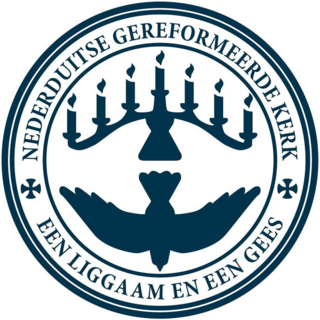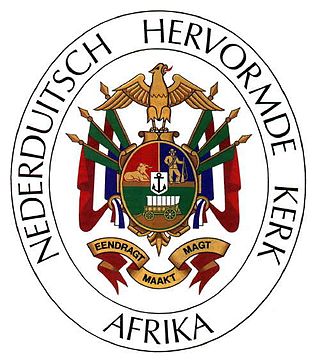
Afrikaner Calvinism is a cultural and religious development among Afrikaners that combined elements of seventeenth-century Calvinist doctrine with a "chosen people" ideology based in the Bible. It had origins in ideas espoused in the Old Testament of the Jews as the chosen people.
The Dutch Reformed Church was the largest Christian denomination in the Netherlands from the onset of the Protestant Reformation in the 16th century until 1930. It was the original denomination of the Dutch Royal Family and the foremost Protestant denomination until 2004. It was the larger of the two major Reformed denominations, after the Reformed Churches in the Netherlands was founded in 1892. It spread to the United States, South Africa, Indonesia, Sri Lanka, Brazil, and various other world regions through Dutch colonization. Allegiance to the Dutch Reformed Church was a common feature among Dutch immigrant communities around the world and became a crucial part of Afrikaner nationalism in South Africa.
The World Alliance of Reformed Churches (WARC) was a fellowship of more than 200 churches with roots in the 16th century Reformation, and particularly in the theology of John Calvin. Its headquarters was in Geneva, Switzerland. They merged with the Reformed Ecumenical Council in 2010 to form the World Communion of Reformed Churches.

The Dutch Reformed Church is a Reformed Christian denomination in South Africa. It also has a presence in neighbouring countries, such as Namibia, Eswatini, and parts of Botswana, Zimbabwe and Zambia. In 2013 it claimed 1.1 million members and 1,602 ordained ministers in 1,158 congregations.
The Belhar Confession is a Christian statement of belief written in Afrikaans in 1982. It was adopted as a confession of faith by the Dutch Reformed Mission Church (DRMC) in South Africa in 1986

The World Communion of Reformed Churches (WCRC) is the largest association of Calvinist churches in the world. It has 230 member denominations in 108 countries, together claiming an estimated 80 million people, thus being the fourth-largest Christian communion in the world after the Catholic Church, Eastern Orthodox Church, and the Anglican Communion. This ecumenical Christian body was formed in June 2010 by the union of the World Alliance of Reformed Churches (WARC) and the Reformed Ecumenical Council (REC).
The Dutch Reformed Church in Africa was a Reformed denomination in South Africa. It was a mission church of the Dutch Reformed Church in South Africa (NGK) exclusively for black people, formed in 1963 during the apartheid era. Originally it was mainly in the Free State and northern Transvaal.
The Netherlands Reformed Churches was a conservative Reformed Protestant Christian denomination in the Kingdom of the Netherlands. The denomination came into existence in 1967 out of a schism within the Reformed Churches in the Netherlands (Liberated).

Protestantism in South Africa accounted for 73.2% of the population in 2010. Approximately 81% of South Africans are Christian and 5 out of 6 Christians are Protestant. Later censuses do not ask for citizens’ religious affiliations. Estimates in 2017 suggested that 62.5% of the population are Protestant.

The Dutch Reformed Church in Africa is a Reformed Christian denomination based in South Africa. It also has congregations in Namibia, Botswana, Zambia and Zimbabwe. Along with the Dutch Reformed Church in South Africa (NGK) and the Reformed Churches in South Africa, the NHKA is one of the three Dutch Reformed sister churches of South Africa. The NHKA retains the old Nomenclature Nederduitsch, the word originally referring to the Dutch language. The word refers to the Low Saxon language today. The Dutch language remained the official language of the church until 1933 when the church started functioning almost exclusively in Afrikaans.
The 1886 Dutch Reformed Church split, also known as Doleantie was the name of a prominent schism in the Dutch Reformed Church which took place in 1886 and was led by the renowned minister Abraham Kuyper. The Doleantie was not the first schism in the Dutch Reformed Church. In 1834 another schism, the Secession of 1834 (Afscheiding van 1834), had led to the formation of the Christian Reformed Church in the Netherlands (Christelijke Gereformeerde Kerk in Nederland).

The Reformed Churches in South Africa is a Christian denomination in South Africa that was formed in 1859 in Rustenburg. Members of the church are sometimes referred to as Doppers.
The Swaziland Reformed Church was founded in 1944 and become a congregation of the Dutch Reformed Church in Africa in 1967. Later the Swaziland Missionary Board was formed to coordinate the missionary work of the Reformed Church in Swaziland. In 1989 Swaziland become a Regional Synod of the denomination. In 1991 the Swaziland Reformed Church became independent and has 20 communities within which it is working. The church was a member of the Reformed Ecumenical Council and later became a member of the World Communion of Reformed Churches.

The Dutch Reformed Church in Namibia is a Christian denomination in Namibia. It is one of ten synods of the Dutch Reformed Church in South Africa (NGK), and the only one outside South Africa. It covers all of Namibia except for the Eastern Caprivi Strip.

The Afrikaanse Protestantse Kerk, also known as AP Kerk, is a South African conservative Reformed Church federation with about 35,000 adherents. The federation consists of 210-240 congregations, mostly in South Africa, although the APK also includes 7 congregations in Namibia and one in London, England.

The South African Sendinggestig Museum was established in 1977 and is currently situated in the centre of Cape Town, Western Cape, South Africa. It is a province-aided museum which receives support from the Government of the Western Cape Province.
Mary-Anne Plaatjies van Huffel was a South African pastor and academic. She was the first female minister to be ordained by a Dutch Reformed Church in Southern Africa.
The Johannesburg East Reformed Church was a congregation of the Dutch Reformed Church in South Africa (NGK) in the Johannesburg suburb of Doornfontein, just east of downtown. It is also known as the Irene Church after the sobriquet of its second and third churches on 1 Beit Street. Five weeks before its centennial, on June 1, 1997, Johannesburg East was absorbed by the Johannesburg Reformed Church (NGK), from whence it had seceded on July 8, 1897.
The Parkhurst Reformed Church was a congregation of the Dutch Reformed Church in South Africa (NGK) that was active from 1944 to 1996 in the Johannesburg suburb of Parkhurst.
The Turffontein Reformed Church was a congregation of the Dutch Reformed Church in South Africa (NGK) in southern Johannesburg, Transvaal. It was founded in 1906 and for years had a large membership, at times exceeding 3,000.










